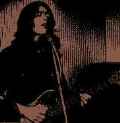 Donal and I went back into the theatre to have a
look at the set up there. There are two stacks of PA per side -
one just above stage level, and another about 20 feet above, on a
platform supported by scaffolding. As for cameras, there are two
peering down from the Circle above us, two in the pit right in front of
the stage, and one roving unit at the back of the stage. This one
is kept well out of the way, however, in order not to obstruct the
audience's view. The whole emphasis is on making the show as much
like an ordinary concert as possible, and in the same way, Rory’s band
are not going in for props such as separation screens, although some
bands are beginning to use these in live recording.
Donal and I went back into the theatre to have a
look at the set up there. There are two stacks of PA per side -
one just above stage level, and another about 20 feet above, on a
platform supported by scaffolding. As for cameras, there are two
peering down from the Circle above us, two in the pit right in front of
the stage, and one roving unit at the back of the stage. This one
is kept well out of the way, however, in order not to obstruct the
audience's view. The whole emphasis is on making the show as much
like an ordinary concert as possible, and in the same way, Rory’s band
are not going in for props such as separation screens, although some
bands are beginning to use these in live recording. Peter Douglas
sneaks behind the
Peter Douglas
sneaks behind the I had noticed the
previous evening that his acoustic instruments were not only being
“aimed” at a microphone, but also had contact mic’s stuck to the
body. What was the advantage of this dual miking? “Well,
with an ordinary mic you get a sense of dynamics. The bug is very
one dimensional, very compressed sounding. So what happens is
that you get it all in one tone and lose out on that rounded feeling
which is what acoustic instruments are supposed to sound like.”
I had noticed the
previous evening that his acoustic instruments were not only being
“aimed” at a microphone, but also had contact mic’s stuck to the
body. What was the advantage of this dual miking? “Well,
with an ordinary mic you get a sense of dynamics. The bug is very
one dimensional, very compressed sounding. So what happens is
that you get it all in one tone and lose out on that rounded feeling
which is what acoustic instruments are supposed to sound like.”